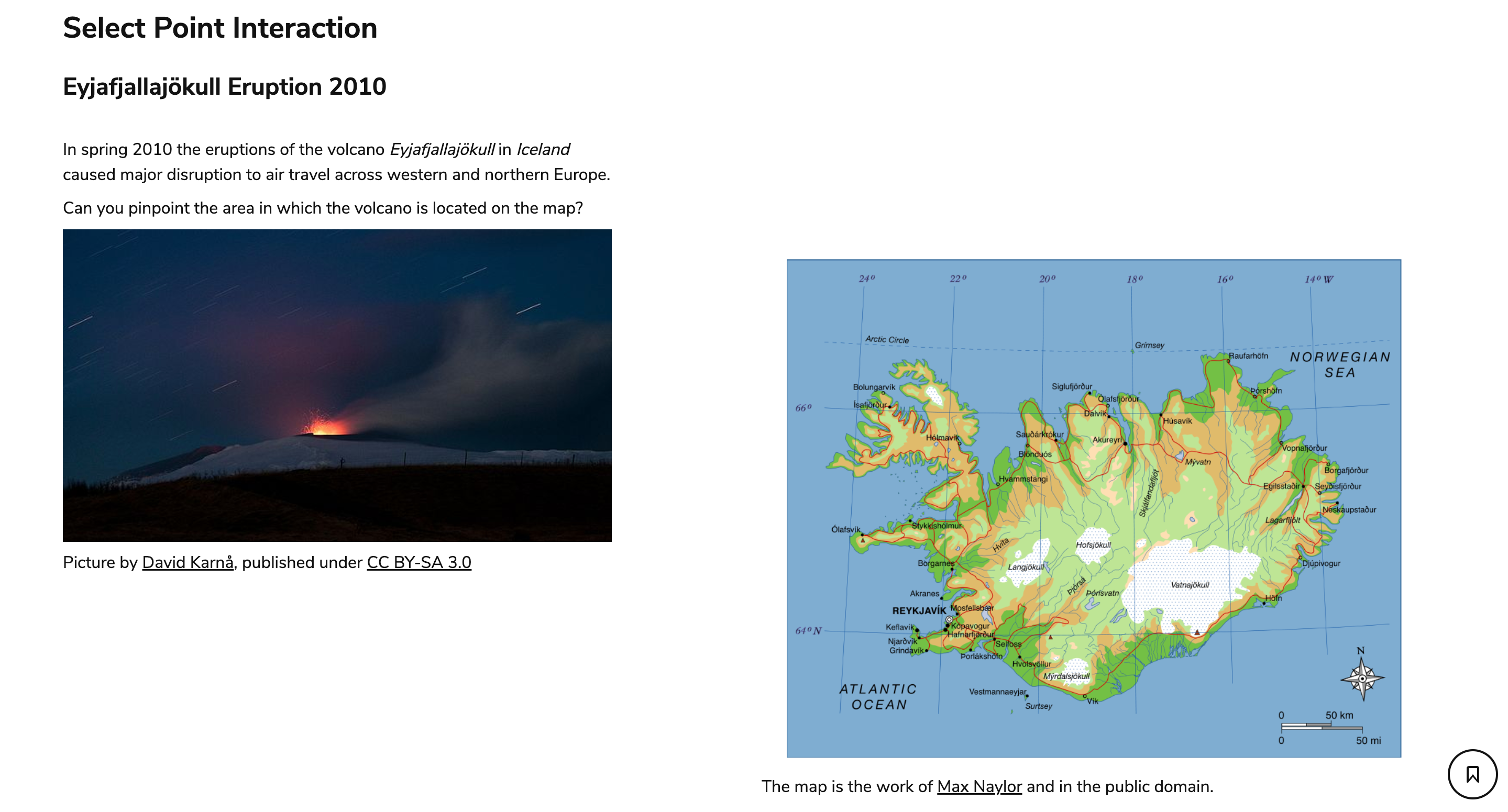Select Point interaction
The Select Point Interaction gives Test-takers the opportunity to demonstrate their knowledge by selecting an invisibly-defined portion of an image (region on a map, person in a line-up, etc.).
This interaction is one of a series of Graphic Interactions (the others are covered in their own sections). All graphic interactions can be found in the Graphic Interactions Library on the left.

Select Point interaction in TAO Advance
Once you have generated a new Item, and clicked on Authoring in the Action Bar, follow the steps below to create a new Select Point Interaction:
1. From the Graphic Interactions library near the bottom of the Interactions library on the left, drag the Select Point icon onto the blank item and drop it onto the Canvas.
2. Choose the desired background graphic.
A Resource Manager window will appear with which you can select a background graphic. You can re-use a background already in the resource manager, or you can upload a new one.
To select one from the list of previously uploaded graphics, highlight the appropriate background graphic in the resource manager list and click the green Select button.
To upload a new one, click on the blue Add file(s) button to browse the files on your computer, and then upload one to the resource manager by clicking the green Upload button.
Highlight the file you have chosen as your background by clicking on it, and it will appear on the right in the preview panel. Click Select in the bottom right of the window to continue.
A new authoring window will appear with the background graphic in the center of the canvas. Above the graphic there is a question field.
3. Fill in the question field, where it says define prompt.
This should cover such important information as what the background graphic represents, and what the test-taker is expected to select in this interaction.
See the chapter Word Processing Options for details on text editing options such as using italics or bold text in your item, and inserting features such as shared stimuli or media, tables or formulae.
4. Complete optional configuration of the interaction if required.
You can choose to configure your interaction in the following ways:
specify the allowed number of selections
These options are available in the Interaction Properties Panel on the right. See the section Configuring Interactions for details.
5. Click Response on the right of blue interaction header to define the correct answer(s).
This opens the graphic with an Associable Hotspot Panel on the left, used for inserting selected shapes that will represent Associable Hotspots into the graphic (these include four different shapes: rectangle, circle, ellipse, and polygon). Below the Hotspot Panel is a trash can icon, which allows the user to delete poorly-placed or misshapen Hotspots.
To insert a rectangle, click on one corner and drag it across the intended area the Hotspot is supposed to cover.
To insert a circle or ellipse, select its center and drag outward or inward until the Hotspot is the right size.
To insert a polygon, begin at one corner, then click on each corner in succession until the Hotspot is complete.
You can make all the shapes bigger or smaller (or in the case of polygons change the shape), but if necessary, click on the problem Hotspot, click the trash can to delete it, and then try again.
6. Insert the Associable Hotspots onto the background graphic.
Test-takers will not see these Hotspots on the background graphic, but selecting a point within the Hotspot will register it as a correct answer.
7. Set the weights to be awarded for each Hotspot.
In the scoring method normally used as a default, a test-taker receives one point per completely correct interaction (so the test-taker has to select all the correct responses in order for the answer to be considered correct).
Select Response in the header bar of the interaction pop-up window, and see Response Properties Panel. In this type of interaction, however, each Hotspot is evaluated individually, and thus Map Response is used as the Response processing method.
By clicking on each Hotspot, a pop-up window appears next to it, which allows you to set the weight to be awarded if the test-taker selects it correctly.
For more details on how to use this scoring method, and how to set the values of the other associated properties, see Configuring automatic scoring.
8. Complete optional configuration of response if required.
You can choose to configure the interaction response in the following ways:
insert modal feedback
These options are available in the Response Properties Panel on the right.
9. Click the blue Done button. Your Select Point interaction is now complete.
You can now preview and test-run your Interaction by following the instructions given in Steps 5 and 6 in Creating a Test Item.
